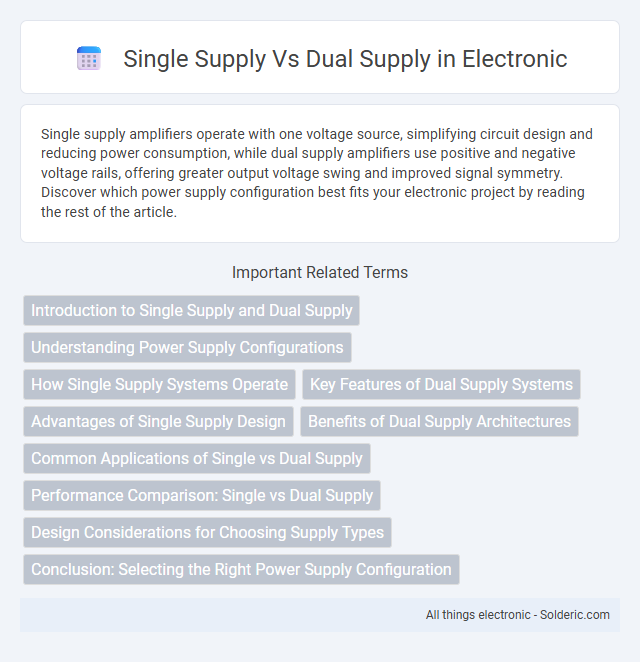Single supply amplifiers operate with one voltage source, simplifying circuit design and reducing power consumption, while dual supply amplifiers use positive and negative voltage rails, offering greater output voltage swing and improved signal symmetry. Discover which power supply configuration best fits your electronic project by reading the rest of the article.
Comparison Table
| Feature | Single Supply | Dual Supply |
|---|---|---|
| Power Source | One voltage source (e.g., +5V) | Two voltage sources (e.g., +15V and -15V) |
| Voltage Range | 0V to positive supply voltage | Negative to positive supply voltage (bipolar) |
| Ground Reference | Signal referenced to ground (0V) | Signal can swing around 0V (ground) |
| Complexity | Simple power design | Requires dual power rails, more complex |
| Application | Battery powered devices, low power circuits | Operational amplifiers, audio circuits, analog devices |
| Signal Handling | Limited to positive voltages | Can handle positive and negative signals |
| Cost | Lower cost, less components | Higher cost, requires additional components |
Introduction to Single Supply and Dual Supply
Single supply systems operate with a single voltage source, typically a positive voltage referenced to ground, making them common in battery-powered and low-voltage applications. Dual supply systems utilize both positive and negative voltage rails relative to ground, enabling signals to swing both above and below zero volts, which enhances linearity and dynamic range in analog circuits. Choosing between single supply and dual supply depends on factors such as signal requirements, power availability, and circuit complexity.
Understanding Power Supply Configurations
Single supply power configurations use one voltage source, typically ground and a positive voltage, ideal for low voltage applications and simplifying circuit design. Dual supply power configurations employ both positive and negative voltage sources relative to ground, enhancing signal swing and reducing distortion in analog circuits. Selecting between single and dual supply depends on the application's voltage requirements, signal range, and noise tolerance.
How Single Supply Systems Operate
Single supply systems operate by using a single voltage source, typically referenced to ground, to power operational amplifiers and other analog devices. These systems rely on virtual ground or level-shifting techniques to accommodate signals that swing both above and below the midpoint voltage, enabling proper analog signal processing. This configuration simplifies circuitry and reduces power consumption, making it ideal for battery-powered and portable applications.
Key Features of Dual Supply Systems
Dual supply systems provide both positive and negative voltage rails, essential for powering operational amplifiers and analog circuits with bipolar signals. These systems enhance signal fidelity by allowing symmetrical voltage swings around zero volts, improving dynamic range and reducing distortion. The presence of dual rails simplifies circuit design in applications requiring zero-volt reference and enables precise handling of AC signals.
Advantages of Single Supply Design
Single supply design offers significant advantages such as simplified power requirements and reduced cost by using only one voltage source, which also enhances energy efficiency in portable and battery-operated devices. It minimizes complexity in circuit design by eliminating the need for creating negative voltage rails, leading to easier implementation and smaller PCB footprints. Your overall system benefits from improved reliability and lower noise interference, making single supply designs ideal for low-power analog and mixed-signal applications.
Benefits of Dual Supply Architectures
Dual supply architectures offer enhanced signal integrity by providing both positive and negative voltage rails, which allows operational amplifiers to handle AC signals more effectively and symmetrically. This configuration reduces distortion and improves the linearity of analog circuits, making it ideal for audio processing and instrumentation applications. Furthermore, dual supplies enable easier biasing and wider dynamic range, resulting in more accurate and stable performance in sensitive electronic systems.
Common Applications of Single vs Dual Supply
Single supply power systems are commonly used in battery-operated devices, portable electronics, and low-power digital circuits due to their simplicity and cost-effectiveness. Dual supply configurations are essential in analog circuits such as operational amplifiers, audio equipment, and instrumentation systems that require positive and negative voltage rails for proper signal processing. Industrial automation and communication devices often implement dual supply to improve performance and signal integrity.
Performance Comparison: Single vs Dual Supply
Dual supply power configurations typically offer better performance in analog circuits by providing a symmetric voltage range, which reduces distortion and improves signal linearity. Single supply systems, while more compact and energy-efficient, may suffer from reduced dynamic range and increased noise due to the need for level shifting and biasing. For high-precision applications, dual supply designs are preferable as they enable cleaner signal processing and enhanced output fidelity.
Design Considerations for Choosing Supply Types
Choosing between single supply and dual supply designs hinges on factors like signal range, noise performance, and complexity of the power system. Single supply circuits simplify power management and reduce cost but may limit output voltage range and require level shifting for signals near ground. Dual supply setups extend voltage swing and improve linearity, essential for analog applications demanding precise signal processing, ensuring your design meets performance and budget requirements effectively.
Conclusion: Selecting the Right Power Supply Configuration
Selecting the right power supply configuration depends on the specific application requirements, where single supply systems offer simplicity and cost-effectiveness for low-voltage circuits, while dual supply systems provide greater signal fidelity and flexibility, especially in analog and operational amplifier applications. Dual supply configurations enhance performance by allowing signals to swing both positive and negative relative to ground, crucial for precision measurement and audio processing. Evaluating factors like voltage range, circuit complexity, and noise tolerance ensures optimal power supply selection for reliable and efficient electronic designs.
Single supply vs Dual supply Infographic

 solderic.com
solderic.com